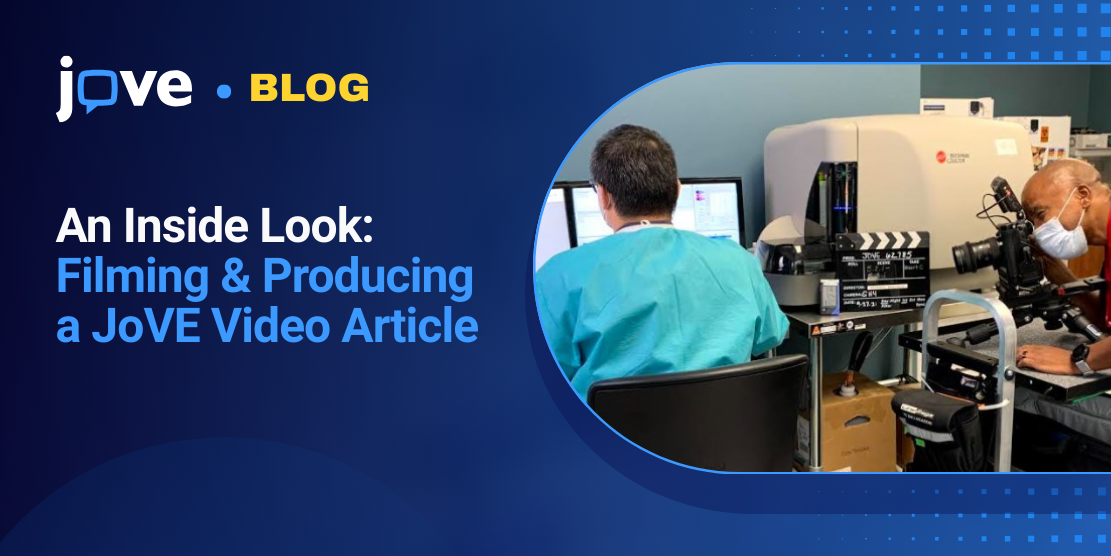When researchers think about publishing, they usually picture writing, revising, and responding to peer reviewers. But what about filming? For many scientists, creating a video article may sound daunting.
In our recent webinar Behind the Scenes: Producing a JoVE Video Protocol, Dr. Kristi Thiel, Assistant Professor at the University of Iowa, shared her team’s experience of turning a complex organoid method into a published video.
The (Manu)script
The process begins much like any other academic article. Authors submit a detailed manuscript, which undergoes peer review. Once accepted, JoVE’s scientifically qualified writers transform the protocol into a visual script, turning written steps into a storyboard for video.
For Dr. Thiel’s team, this stage involved close collaboration with JoVE staff. “They took our manuscript and generated a really cohesive script based on the steps we outlined,” noted her graduate student, Katie. Together they decided what needed to be shown on screen and what could remain as supporting narration or notes.
On Set in the Lab
The next stage is filming. JoVE draws on a global network of videographers to make this possible for labs around the world, although researchers can also submit their own footage.
In Iowa, the filming process ran smoothly thanks to the videographer’s support. Dr. Thiel emphasized how helpful it was to have someone guide them through the day: he prepared enlarged scripts taped near the camera, encouraged multiple takes, and even provided professional still shots for use on lab websites.
As she explained, “As researchers, we're used to getting on podiums and giving talks, but we're not used to being videoed. It just creates this whole extra anxiety and stress of 'What am I going to say? I'm going to look stupid on camera.' And he just really made us feel comfortable.”
This kind of support is echoed across social media, where researchers often share snapshots of their filming days. The Genzel Lab in the Netherlands likened their experience to Hollywood coming to their lab, while the West Point Department of Geography and Earth Sciences in the US shared photos and thanked the JoVE videographer for his support through the process.
For many researchers, the idea of being filmed can be intimidating. Nikki Noren Hooten, a staff scientist at the NIH, admitted she felt the same at first. But once the process began, her perspective shifted: the teleprompter meant there was no need to memorize lines, the filming itself was wrapped up in a few hours, and the videographer kept everything seamless and easy. Looking back three years later, she noted that the video they produced had been viewed more than 11,000 times—a clear sign of its lasting reach and impact.
Production to Publication
Once filming wraps, the footage goes to JoVE editors, who handle cutting, voiceover, and final production. The result is a polished video article indexed in PubMed, Scopus, and other major databases, ensuring visibility and academic credibility.
For Dr. Thiel’s group, the published video quickly became a valuable tool for training, conference talks, and sharing with the broader community. Instead of explaining every nuance of the method, they could simply share the article link.

Why Video Matters
The benefits of publishing in video format go far beyond visibility. As many researchers have pointed out, video helps address challenges related to efficiency, productivity, and reproducibility— all critical in today’s research environment.
Training: New lab members can learn complex procedures faster.
Knowledge transfer: Videos prevent loss of expertise when staff leave.
Reproducibility: Viewers see exactly how a step is performed, improving consistency between researchers and labs.
Collaboration: Sharing a link can save hours of explanation or avoid the need to travel for in-person demos.
Final Thoughts
Publishing in video format transforms how research is shared. Instead of relying on text alone, complex methods are shown in action, making them clearer, more reproducible, and more impactful. For Dr. Thiel’s group, one of the most valuable outcomes was being able to reference the video in grant proposals and collaborations, using it to demonstrate feasibility of their method and attract new partners.
For researchers considering the process, the message from those who’ve done it is clear: you don’t have to be a filmmaker. The JoVE team guides you through every stage. And the final result presents your science in a way that words alone simply cannot capture.

